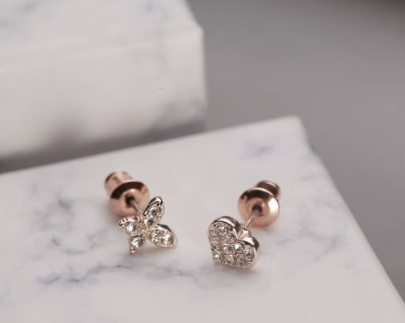Diamond stud earrings are a popular choice for earrings, whether you’re buying them for yourself or as a gift for someone else. Let’s take a look at the most important factors you should consider when choosing diamond earrings.
Choose the Diamond Color of Your Earrings
Diamond color is graded alphabetically, with D being the highest, followed by E and F, all of which indicate that the gemstone is colorless.

However, it would be a bit of a waste of money to buy such a high-grade diamond for stud earrings: these diamonds are small, and looking at them from a great distance, no one will be able to tell if their color is D/E/F or a lower grade, such as G/H/I/J.
Diamonds in the HJ series of colors will serve you just as well as better colored gemstones – the difference will be invisible, but you’ll save yourself a ton of money if you don’t opt for the absolute top option.
Diamond Clarity and Earrings
Similar to color, diamond clarity is graded using letters, and just like choosing the best color won’t make a noticeable difference, choosing the highest clarity grade over a slightly lower alternative will cost you a lot of money but won’t yield noticeable benefits.
That’s why it’s best to skip FL (Flawless) and IF (Internally Flawless) diamonds and opt for SI1 or SI2 diamonds, whose imperfections won’t go unnoticed when wearing earrings.
Keep in mind that diamonds of the same clarity grade may differ in the visibility of the defect, and some SI2 gemstones may have noticeable inclusions.
That’s why you should double-check the stud earrings you want to buy and choose a diamond that looks clean to the naked eye.
If the clarity of the gemstone is not graded, choose the cheapest gemstone that looks fairly clean from a normal viewing distance.
Choose the Diamond Cut of the Earrings
According to GIA (Gemological Institute of America), the highest cut grade is “Excellent,” followed by “Very Good,””Good,””Fair” and “Poor.”
Generally speaking, a good cut is sufficient for diamond stud earrings, and the difference between this grade and the excellent grade will not be easily noticed.
If you choose diamond stud earrings with round gemstones, make sure they are not too deep, as such diamonds have fewer visible surfaces than better-cut diamonds.
The Size of the Diamond in the Earrings
The size of the diamonds in the stud earrings is a matter of taste, but you should keep in mind that as the gemstones get larger, their imperfections will increase and become more noticeable, and any yellow hues in gemstones of lower grade color will be lightened. More obvious.

That’s why you may want to pay special attention to these quality characteristics, for example, if you buy 1 carat diamonds, and make sure they look clean and colorless.
Diamond Earrings Setting
There are different types of settings to choose from, the most popular being prong and bezel settings. In general, borders are safer because they hold diamonds in place by wrapping them around them with a metal band.
The disadvantage of a bezel setting is that it also hides more diamonds than a prong setting. Prongs are less secure as they are more likely to bend or break, but they will make more of the stone visible.
Whatever you choose, you should make sure that the construction of the earrings is strong enough and that they don’t look like they fall apart easily.
Choose Metal Earrings
One of the factors to consider when choosing diamond earring metal is durability. For example, yellow gold is softer than white gold, and if you’re looking for earrings with parts that don’t bend or scratch easily, yellow gold is a better choice.
A better option is platinum, but it’s also much more expensive.
If you’re wearing yellow gold, whether white or yellow, ask if the earrings contain nickel – not everyone is allergic to it, but to be on the safe side, it’s advisable to buy jewelry with less nickel content (like 14-carat or 18-karat gold) or no nickel at all.
You can also consider clothing, hair color, and skin tone, and consider them when choosing a metallic color. For example, gold complements dark tones, while white metals are better suited to light tones.
